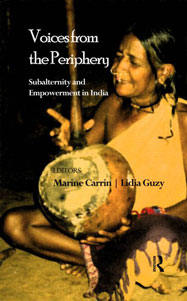“It is wrong and does not help the tribal cause either to reduce the image of the Indian tribal society to that of destitute remnants, on the verge of dying out.” – Georg Pfeffer in Voices from the Periphery: Subalternity and Empowerment in India (Routledge India 2012)

A rare collection of essays and different from most anthropological writing: its authors highlight the insider perspective of Adivasi and several other communities.
Voices from the Periphery: Subalternity and Empowerment in India
Edited by Marine Carrin, Lidia Guzy
Published 1st March 2012 by Routledge IndiaIn India as elsewhere, peripheries have frequently been viewed through the eyes of the centre. This book aims at reversing the gaze, presenting the perspectives of low castes, tribes, or other subalterns in a way that amplifies their ability to voice their own concerns.
This volume takes a multidimensional perspective, citing political, economic and cultural factors as expressions of the autonomous assertions of these groups. Questioning the exclusive definitions of the Brahmanical, folk and tribal elements, the articles bring together the empowering possibilities enabled by three recent theoretical developments: of anthropologies questioning the fringes of mainstream society in India; critically engaged histories from below, which problematize subaltern identities; and a conceptual emphasis on everyday ethnography as an arena for negotiations and transactions which contest wider networks of power and hegemony.
This book will be useful to those in sociology, anthropology, politics, history, study of religions, minority studies, cultural studies and those interested in social development, and issues of marginality, tribes and subaltern identity.
Introduction 1. Nisad of the Ganga: Playing with the notions of margin and centre Djallal Heuzé 2. From History to Heritage: Adivasi Identity and Hul Sengel Dan Rycroft 3. On entering the remote area: Recent German anthropological research in western Orissa Georg Pfeffer 4. The history of the royal family of Bonai: Texts, centres and authorities Uwe Skoda 5. Village festival and kingdom frame: Centre and periphery from a Porajâ village point of view, southern Orissa Raphaël Rousseleau 6. The poly-culture of Mahima Dharma: On ascetics and Shamans in a new religious movement of Orissa Lidia Guzy 7. Gonasika, a tribal sacred place and a Hindu centre of pilgrimage Cécile Guillaume 8. The Billavas of Karnataka and the Santals of Orissa: Two peripheries asserting their position towards the center Marine Carrin 9. Towards a comparison of traditional centre–periphery relations in two regions on the west coast of India: Saurashtra and south Kanara Harald Tambs-Lyche 10. Brahmans of the Pariyas, peripheries in quest of identity Alexis Avdeeff 11. Did the subaltern speak? Radhika Borde. About the Editors. Notes on Contributors. Index.
Marine Carrin is Director of Research, Centre National de la Recherche Scientifique (CNRS), LISST-Centre d’Anthropologie, Toulouse, France.
Lidia Guzy is Associate Researcher, Institute for Scientific Studies of Religions, Free University of Berlin.
Source: Voices from the Periphery: Subalternity and Empowerment in India (Hardback) – Routledge
Address : https://www.routledge.com/books/details/9780415501774/
Date Visited: 30 October 2021

Jawaharlal Nehru on five principles for the policy to be pursued vis-a-vis the tribals >>
Photo © Indian Express
Find scholarly books, poetry and fiction relating to tribal culture – Indian publishers
List of sites covered by this Google custom search engine
To find children’s and educational books or search Indian periodicals, magazines, web portals and other sources safely, click here >>
Search tips
Combine the name of any particular state, language or region with that of any tribal (Adivasi) community.
Add keywords of special interest (music, poetry, dance just as health, sacred grove and biodiversity); learn about the rights of Scheduled Tribes such as the “Forest Rights Act” (FRA); and the United Nations “Declaration on the Rights of Indigenous Peoples”, “Universal Declaration of Human Rights”, “women’s rights”, or “children’s right to education”.
Ask a question that includes “tribal” or “Adivasi”, for instance: “Adivasi way of life better?” (or “tribal way of life worse?”)
Specify any particular issue or news item (biodiversity, bonded labour and human trafficking, climate change, ecology, economic development, ethnobotany, ethnomedicine, global warming, hunter-gatherers in a particular region or state, prevention of rural poverty, water access).
For official figures include “scheduled tribe ST” along with a union state or region: e.g. “Chhattisgarh ST community”, “Himalayan tribe”, “Scheduled tribe Tamil Nadu census”, “ST Kerala census”, “Particularly Vulnerable Tribal Group Jharkhand”, “PVTG Rajasthan”, “Adivasi ST Kerala”, “Adibasi ST West Bengal” etc.
In case the Google Custom Search window is not displayed here try the following: (1) toggle between “Reader” and regular viewing; (2) in your browser’s Security settings select “Enable JavaScript” | More tips >>
Note: hyperlinks and quotes are meant for fact-checking and information purposes only | Disclaimer >>